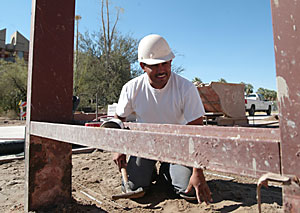 |
|
KEVIN B. KLAUS/Arizona Daily Wildcat
|
Miguel Gallego works on the sign that will read "Alumni Plaza" outside the Administration building Wednesday. The new Alumni Plaza will be completed in time for Homecoming.
|
|
|
By Natasha Bhuyan
Arizona Daily Wildcat
Friday, October 22, 2004
Print this
The northern part of the Alumni Plaza next to the Administration building will open to the public today, after five years of planning and nearly a year of construction.
The rest of the 108,000 square-foot Alumni Plaza will be officially opened and dedicated Oct. 29, corresponding to the Arizona Alumni Association's Homecoming, "The Bash at Alumni Plaza."
Funded entirely by alumni and private donors, the Alumni Plaza, which cost $5 million, will be presented as a gift to the student body from UA alumni.
Kay Brown, Arizona Alumni Association board member, said the project was first initiated to strengthen the connection between UA alumni and the student body by symbolically celebrating the rich heritages and traditions of the UA.
"We want to create a sense of community across generations," Brown said.
Sandra Ruhl, president of the UA Alumni Association, said the Plaza will provide students with shaded seating for solitary time, one-on-one conversations and small discussion groups, as well as areas for activities and performances.
"By providing a comfortable, attractive place where people can spend time together, we believe Alumni Plaza will help create an even greater sense of community on our campus," Ruhl said.
A prominent feature of Plaza will be a 14-feet-tall bronzed sculpture, titled "The Wildcat Family," depicting Wildcat parents guarding two cubs, which is symbolic of the relationship between alumni and students, as well as the campus community.
"The University of Arizona Wildcat Family name is symbolic of the family that it takes to make a university work - faculty, staff, students, staff - it takes a community," said Anne Lopez, program coordinator for the alumni office.
Sculpted by Nicholas Wilson, the art piece cost $170,000 and will be dedicated to a donor who will be revealed at the Oct. 29 ceremony.
Philip May, chair of the Alumni Association in 1999 and president of Associated Students at the University of Arizona in 1980, conceived the idea of the Alumni Plaza after taking an interest in the UA's extensive history, which pre-dates statehood.
May said the Plaza is an opportunity to educate students, as well as strengthen the relationship between alumni and students. Since all alumni were students at one time, May said the two groups share more in common than they realize.
"Some experiences at the UA are exactly the same," May said. "Any community of people that understand and embrace that will create a stronger bind with that institution."
To provide students with a better understanding of the UA, historical facts are subtly engraved in various parts of the Alumni Plaza, said May.
Wildcat Walk will have information about the UA written on granite, such as the first graduating class was two females and one male, while the University Mission Fountains will state the four missions of the UA.
Each fountain has eight pieces of granite, which are twice as strong as concrete, weighing 6,000 lbs. The largest fountain will have 125 jets of re-circulated water while the smallest one will have 65 jets, Lopez said.
But the construction of the Alumni Plaza has not been without its share of problems. In 2002, the project was overwhelmingly opposed by the student body after alumni revealed plans of moving the Krutch Cactus Garden to a location near Old Main.
The cactus garden, which has been a part of the university since 1891, contained rare boojum trees that students feared would be destroyed during the move.
After negotiations with students and community members, alumni agreed to preserve the garden and incorporate it into the Alumni Plaza.
"I think it's cool they kept it," said Christine Schirmer, a general biology major. "And it's been done pretty quickly."
The Scholar's Grove, Founder's Grove, and Alma Mater Terraces will also contain an assortment of environmental landscape, such as mesquite trees, evergreen elms, red oaks, and palo verdes, which will be dedicated to each of the founders of the UA as well as the three land donors and alumni.
The Oct. 29 dedication ceremony, which begins at 5 p.m., is open to the public and will include mariachis, Native American dancing, African drumming, "Roaring '20s" dancing, the UA Alumni Band, an a cappella group performance, and Hawaiian dancing. Classic cars from the T-Bird and Corvette Car Clubs will encircle the area.
